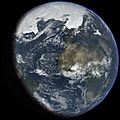Future of the Earth facts for kids
The future of the Earth will depend on many things. These include how much brighter the Sun gets, the loss of heat from the Earth's center, and changes to the planet's path around the Sun caused by other objects in the Solar System. The Milankovitch theory suggests that Earth will keep having glaciation cycles. These are due to small changes in Earth's orbit, the tilt of its axis, and how its orbit wobbles. Also, as part of the supercontinent cycle, plate tectonics might form a new supercontinent in about 250 million to 350 million years. In the next 1.5 billion to 4.5 billion years, the Earth's tilt might change a lot, possibly up to 90 degrees.
About one to two billion years from now, the solar radiation will increase because helium builds up in the Sun's core. This will cause Earth's oceans to disappear and continental drift to stop. In four billion years, the Earth's surface temperature will rise, leading to a severe greenhouse effect. By then, most, if not all, life on Earth will be gone. The most likely end for our planet is to be destroyed by the Sun in about 7.5 billion years. This will happen when the Sun becomes a red giant star and expands past Earth's orbit.
Contents
Human Impact on Earth's Future
Humans now play a huge role in the biosphere. There are many people living in most of Earth's ecosystems. This has led to a widespread and ongoing extinction of other species, known as the Holocene extinction. This extinction event is happening because of habitat destruction, the spread of invasive species, hunting, and climate change.
How the Sun Will Change
The Sun creates energy by turning hydrogen into helium in its core. This process powers the Sun.
When the Sun first became a main sequence star, it was only 70% as bright as it is today. Its brightness has slowly increased over time, going up by 1% every 110 million years. In three billion years, the Sun is expected to be 33% brighter than it is now. The hydrogen fuel in its core will finally run out in about 4.8 billion years. At that point, the Sun will be 67% brighter than it is today. After this, the Sun will continue to burn hydrogen in a shell around its core. Its brightness will increase until it is 121% of its current value. This marks the end of the Sun's main sequence life. After this, it will turn into a red giant star.
Related pages
- Habitable zone
- Planetary habitability
- Risks to civilization, humans and planet Earth
- Stability of the Solar System
Images for kids
-
Drawing of the Earth after the Sun goes into the red giant phase, seven billion years from now.
-
Horne foundry copper smelter in Rouyn-Noranda, Canada
-
Anti-nuclear weapons protest march in Oxford, 1980
-
The Barringer Meteorite Crater in Flagstaff, Arizona, showing evidence of the impact of celestial objects upon Earth
-
The atmosphere of Venus is in a "super-greenhouse" state. Earth in a few billion years could likely resemble present Venus.
-
The Helix nebula, a planetary nebula similar to what the Sun will produce in 8 billion years
See also
 In Spanish: Futuro de la Tierra para niños
In Spanish: Futuro de la Tierra para niños










